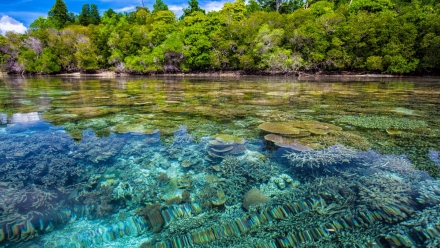Queensland Water Management in 2050
What if our past knowledge about trends in water and riverine ecosystems isn’t reliable for predicting change?
What do plausible futures look like and what actions can we take to move towards our preferred future?
Prof. Tony Jakeman, Dr. Baihua Fu and members of the IWF, led a project exploring water management and related cross-sectoral decision making in the face of deep uncertainties. The project aims to develop participatory foresighting approaches for considering multiple plausible futures in regard to water and natural resource management in Queensland, and test methods for translating this information into water models. Initially the project will focus on the Great Barrier Reef catchments with the potential for expansion to South East Queensland catchments and the northern Murray Darling Basin.
This project was funded by the Queensland Water Modelling Network (QWMN) and the IWF. The Department of Environment and Science is responsible for the coordination and governance of the QWMN in a partnership with the Department of Natural Resources, Mines and Energy and the Queensland Reconstruction Authority. The collaborative team comprised researchers from IWF and UNSW, and with Queensland government and private industry partners.
Current water and riverine ecosystem monitoring and modelling approaches are useful in providing insight into past and emerging trends in water and riverine ecosystems, and exploring “what-if” scenarios. However, models are ill-equipped to predict how the environment will respond to a wider range of plausible dynamics and accelerating changes in the future. Too much focus on past, quantifiable, linearly extrapolated knowledge can limit innovative ways of navigating and co-envisioning more sustainable pathways to enhance water and riverine ecosystem health through an uncertain future in the medium to long term. Foresight approaches employ futures thinking and participatory research to discover the perspectives of many different futures. Potential expert-based and participatory scenarios will be explored with industry end users, including changes in climate (including climate extremes), land-use, agricultural and energy markets, tourism, and multi-cross-sectoral policies.
Project Objectives:
Objective 1: Envision medium-long term multiple plausible scenarios for Queensland catchments’ water quantity and quality, and ecosystem outcomes.
Objective 2: Identify opportunities and intervention pathways to achieve desirable outcomes in water and associated resources for the Qld catchments.
Objective 3: Test methods of translating scenario and intervention pathway information into water models.
Project outcomes include capacity building of QWMN water and other relevant sectoral modellers, practitioners, managers and policy makers in:
- Considering significant landscape scale deviations from current model outputs, and methods of incorporating them into model development
- Communicating uncertainty in models and in the value of foresighting exercises for more sustainable futures
- Broadening participants’ views beyond the operational environment into the broader integrated biophysical-social-economic modelling space, and challenging them to explore future and novel opportunities for desirable system outcomes at landscape and larger catchment scales
- Building trust and encouraging collaboration among participants across a wide range of backgrounds/responsibilities from paddock to catchment to receiving water bodies.
Publications
Elsawah, S., Hamilton, S., Jakeman, A., Rothman, D., Schweizer, V., Trutnevyte, E., Carlsen, H., Drakes,C., Frame, B., Fu, B., Guivarch, C., Haasnoot, M., Kemp-Benedict, E., Kok, K., Kosow, H., Ryan, M., van Delden, H., 2020. Scenario processes for socio-environmental systems analysis of futures: A review of recent efforts and a salient research agenda for supporting decision making, Science of The Total Environment, 729, 138393. doi.org/10.1016/j.scitotenv.2020.138393.
Acknowledgement of Country
The Australian National University acknowledges, celebrates and pays our respects to the Ngunnawal and Ngambri people of the Canberra region and to all First Nations Australians on whose traditional lands we meet and work, and whose cultures are among the oldest continuing cultures in human history.





